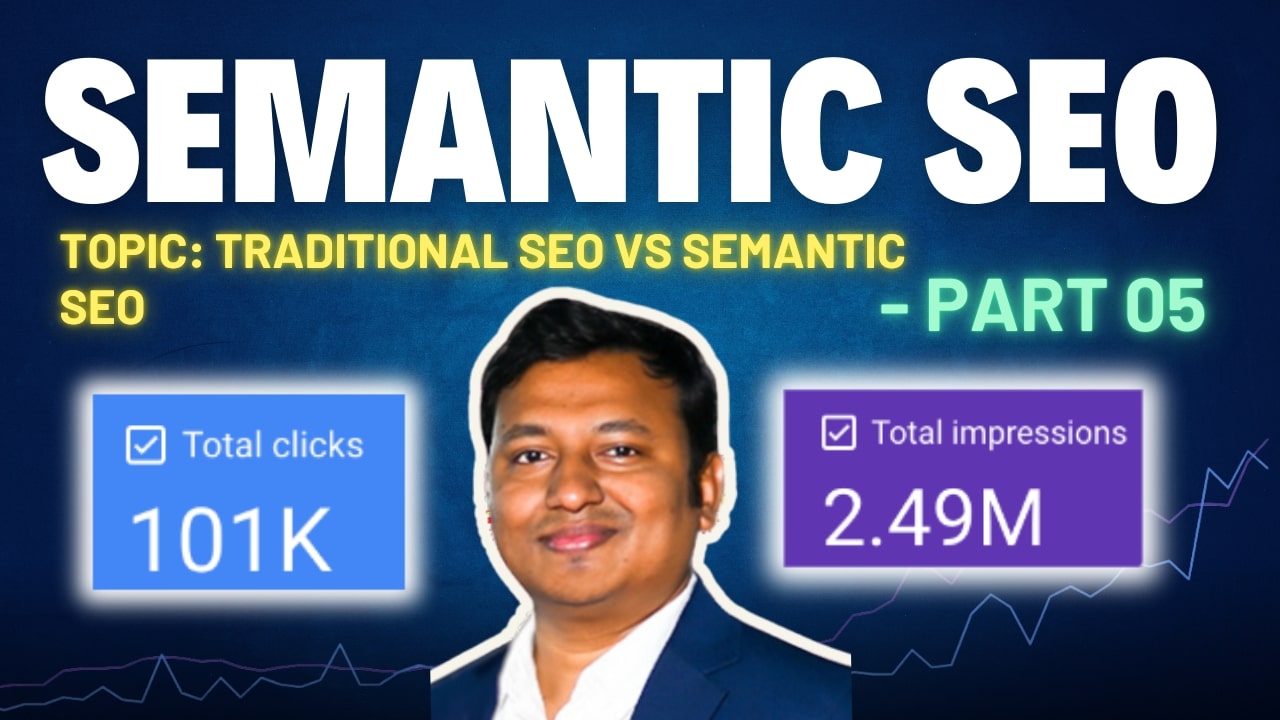The phrase “SEO is dead” isn’t wrong—it’s just incomplete. What’s dying is traditional SEO—the approach rooted in manual keyword stuffing, thin content, backlink chasing, and superficial topical coverage. What has emerged in its place is a smarter, deeper, and structurally sound discipline: Semantic SEO.
In this article of our Semantic SEO series, we explore the critical differences between traditional and semantic SEO, and we show why SEO in 2025 demands an entity-first, NLP-powered, intent-aligned framework—not outdated keyword spreadsheets.
Traditional SEO: A Quick Breakdown of the Old Model
Step-by-Step Traditional Workflow (Pre-2011, Still Used by Some)
- Select a Primary Keyword
- Focus on high-volume terms
- Example: “what is backlink”
- Keyword Volume & Competition Analysis
- Tools: Google Keyword Planner, Ubersuggest
- Include LSI Keywords & Variations
- “link building,” “off-page SEO,” “backlink profile”
- Create Basic Headings & FAQs Based on Keywords
- H2s like “what is backlink in WordPress”
- Repeat for Every Topic in Isolation
- No semantic connection, no content hierarchy, no structured relationships
This model worked well until Google got smarter. Then, it failed spectacularly.
ALSO READ …
- What is Semantic SEO
- Semantic SEO definition step-by-step guide & glossary
- What should you learn in Semantic SEO
- What is query semantics
- What is entity-based content
Semantic SEO: The Modern Framework for Ranking in 2025
Semantic SEO flips the focus:
- From keywords → to entities
- From volume → to intent
- From pages → to topical maps
- From content quantity → to content architecture
Core Technologies Powering Semantic SEO:
- Natural Language Processing (NLP)
- Knowledge Graphs & Entities
- Topical Authority & Internal Linking
- Structured Data (Schema)
- Machine Learning-Based Query Understanding
Keyword vs Entity: The Paradigm Shift
| Aspect | Traditional SEO | Semantic SEO |
|---|---|---|
| Core Unit | Keywords | Entities |
| Optimization Target | Search terms | Meaning & Context |
| Search Engine Logic | String Matching | Intent Modeling (NLP) |
| Ranking Factor | Backlinks & Meta Tags | Entity Salience, Topical Coverage |
| Structure | Flat | Hierarchical (Topical Maps) |
| Content Scope | Standalone Articles | Interlinked Content Networks |
From this Traditional SEO vs Semantic SEO comparison, you understand the pattern of how Google follows Semantic meaning of words, not keywords.
Practical Example: “What is a Backlink?”
Traditional SEO Approach:
- Repeats keyword “backlink” multiple times
- Adds related LSI terms: “link building,” “off-page SEO”
- No context, no hierarchy, minimal value
Semantic SEO Approach:
- Focuses on entity relationships:
- What is a backlink?
- How does it affect domain authority?
- What is the relationship between guest blogging, PBNs, nofollow/dofollow?
- How is Google’s link graph structured?
- Extracts entity suggestions using:
- Google Image “Related Terms”
- Google NLP API
- SERP entity co-occurrence
Result: A contextually rich article with high entity density, salience, and intent fulfillment.
The Role of NLP and Semantic Search
What is NLP?
Natural Language Processing is the ability of machines (search engines) to understand:
- Word meanings
- Phrase contexts
- Sentence structures
- User intent
Example: “Football” in UK = “Soccer” in US
NLP distinguishes contextual meaning based on region, user behavior, and surrounding entities.
Semantic Search Defined:
“A technology that interprets the meaning of words and phrases—not just the literal text.”
Google no longer matches strings. It matches:
- Intent
- Entity relevance
- Topical completeness
How to Migrate from Traditional to Semantic SEO
Continue Doing:
- Use primary keywords
- Add supportive subheadings
- Build internal links
But Also Start Doing:
- Entity extraction: From Google SERPs, image suggestions, NLP tools
- Topical map planning: 200–300 articles around a niche
- Internal linking by entity proximity: not just relevance
- Structured data markup:
@type,mainEntity,sameAs, etc. - Contextual variation: Use correct lexical choices depending on target audience (e.g., “soccer” vs. “football”)
Tools for Semantic Content Optimization
| Purpose | Tool |
|---|---|
| Entity Extraction | Google NLP API, InLinks, Kalicube, TextRazor |
| Topic Planning | Surfer SEO, MarketMuse, Frase, Thruuu |
| SERP Entity Mining | Google Images, Autocomplete, “People Also Ask” |
| Schema Implementation | RankMath, Schema.org Generator, Merkle’s Markup Tool |
| NLP Scoring | On-Page.ai, Server SEO |
Server SEO stands out as one of the most robust tools for entity-based content generation and NLP optimization.
Real-World Use Case: Expert vs Blogger Content
Scenario: Two people write about buying a laptop
| Type | Style | Semantic Signals |
|---|---|---|
| Blogger | “Top 10 laptops under $1000” | Uses vague terms like “good,” “fast,” “cheap” |
| Expert | “Best laptops with AMD Ryzen 7, 1TB SSD, 144Hz Display” | Uses technical specs, brand entities, product line relationships |
The expert wins—because:
- They use real entity attributes (CPU, SSD, Display Type)
- Their content shows experience and trust (E-E-A-T)
- Their internal linking builds a topical map across 200+ laptop pages
Final Thoughts: Why Semantic SEO is Not Optional
SEO is not dead. Traditional SEO is.
If you’re not working with entities, intent, and contextual alignment, you’re not doing SEO for Google in 2025.
Semantic SEO Is:
- The answer layer between query and document
- The framework that aligns search engines and users
- The future of organic visibility, rooted in language understanding
Coming in Part 6: What is Semantic Search? How Google Uses Semantics to Rank Content in 2025
Disclaimer: This [embedded] video is recorded in Bengali Language. You can watch with auto-generated English Subtitle (CC) by YouTube. It may have some errors in words and spelling. We are not accountable for it.
